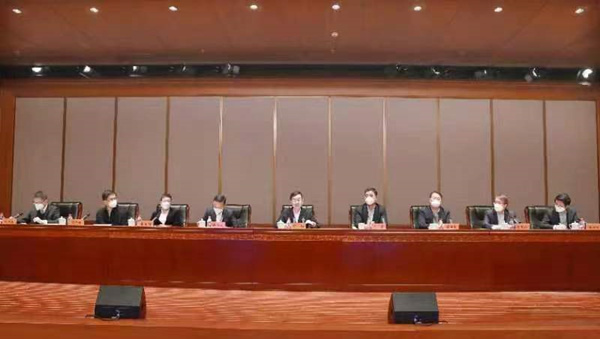

On Feb. 22, the Archaeology Forum of the Chinese Academy of Social Sciences (CASS): China’s New Archaeological Discoveries of 2022 was held in Beijing. The forum released six selected projects for the 2022 Chinese archaeological finds, namely, the Xuetang Liangzi Paleolithic site in Shiyan City, Hubei Province; the Sitai Neolithic ruins in Shangyi County, Hebei Province; the Nanzuo Neolithic site in Qingyang City, Gansu Province; the Shang royal tomb area and surrounding relics at the Yinxu site, or the Yin Ruins, in Anyang City, Henan Province; the Hebosuo Bronze Age relics site in Kunming City, Yunnan Province; a porcelain kiln site from the Western Xia Dynasty (1038–1227) at Suyukou, Helan County, Ningxia Hui Autonomous Region.
In his speech at the forum, CASS President Gao Xiang pointed out that archaeology in China achieved fruitful results in 2022 under the scientific guidance of the spirit of General Secretary Xi Jinping’s important remarks on historical and archaeological research. New discoveries and new progress were made in the field excavations of Paleolithic, Neolithic, and historical dynasty archaeology, providing rich and detailed information for deeper research on major topics including the origins of Chinese civilization, civilizational processes, and exchanges and mutual learning among civilizations.
The major new archaeological discoveries selected this time showcase the achievements of China’s archaeological work in 2022 and the latest development of Chinese archaeology in the new era.

CASS leaders, including Gao Xiang (left), present medals and honor certificates to representatives of selected projects. Photo: Zhu Gaolei/CSST
The fossil designated as “No.3 Skull of Yunxian Man” found at the Xuetang Liangzi site in Shiyan, Hubei, is the most intact Homo erectus specimen of its age found in inland Eurasia so far. It retains important and rare anatomical features of humans at this stage of evolution. Representing an intermediate and key point in the nearly 2 million years of ancient human evolution, the fossil has confirmed the early presence of hominids in China and provides concrete, pivotal evidence for studies of the evolutionary model of ancient humans, the origins of Homo erectus, and the evolutionary relationship between Homo erectus and Homo sapiens, in East Asia.
The regional features exhibited in the Sitai Neolithic ruins in Hebei’s Shangyi County connected the north and south of the Yanshan Mountain and the West Liaohe River Basin, constituting a large cultural area: the Yanliao Cultural Area. This not only fills the gap in research of the early Neolithic culture in the area, but also offers valuable materials for the study of the Paleo-Neolithic transition, the origins of agriculture, cultural pedigree, and human transition from nomadic to settled life. It is solid evidence of the 10,000-year cultural history in north China.
At the Nanzuo Neolithic site in Qingyang, Gansu, the core area encircled by nine terraces and a clearly laid out palace area were unearthed alongside large palace buildings and numerous high-grade pottery objects. It’s suggested that this was a large-scale, advanced central settlement with the nature of a city belonging to the late period of the Yangshao Culture, dating back 4,700 to 7,000 years across the northern part of China. It also proves that the Longdong area, namely Qingyang, entered the early state or civilized society stage around 5,000 years ago. This is of great significance to objectively understanding the key position of the Loess Plateau in the origination and formation of Chinese civilization, and to evidencing the history of Chinese civilization of more than 5,000 years.
Archaeological excavations at the Shang royal tomb area and surrounding relics at the Yin Ruins in Anyang, Henan, determined the scope of the mausoleum area, and pushed up the time of the appearance of trenches surrounding royal tombs from the Spring and Autumn Period (770–476 BCE) to the late Shang Dynasty (c. 16th century–11th century BCE). These discoveries will fuel studies of the mausoleum system, as well as the culture and history of the Shang Dynasty, while providing new and important materials for the construction of the national Yinxu archaeological site park. In addition, large-scale drilling has helped obtain systematic burial information of regional underground cultural relics, especially concerning the depths of important underground cultural layers, providing crucial reference data for subsequent restorations of the ancient landform of the Yinxu site.
A batch of precious cultural relics including inscribed clay seal impressions as well as bamboo and wooden slips were unearthed at the Hebosuo relics site in Kunming, Yunnan, indicating that the central court had implemented effective administrative jurisdiction over the present-day Yunnan area during the Western Han Dynasty (206 BCE–8 CE). The cultural remains revealed by the archaeological excavations at the site have constructed a complete archaeological cultural sequence from the Shang and Zhou (c. 11th century–256 BCE) dynasties to the Qin (221–207 BCE) and Han (206 BCE–220 CE) era in the Dianchi Basin, vividly demonstrating the full process of the region developing from “diversity” to “unity” and finally integrating into the community of the Chinese nation.
At the Western Xia porcelain kiln site at Suyukou, Helan, Ningxia, complete workshop remains, including two kilns, were unveiled, and a new type of kiln industry—Helan kiln—was discovered. These finds have filled in the blank of firing fine whiteware artifacts in northwest China. The complex kiln appearance shows that the Western Xia porcelain kiln field, based on the traditional kiln technology in north China, absorbed many advanced kiln technologies from the south, such as the Hutian kiln and Yue kiln. This attests to the historical facts of ethnic and cultural exchanges, interaction, and integration in the Song Dynasty (960–1279).

A scene of the forum Photo: Zhu Gaolei/CSST